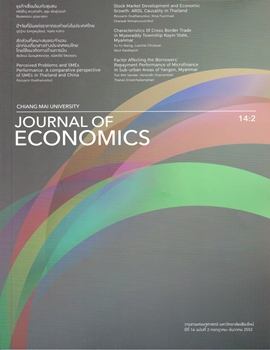ธุรกิจเชื่อมโยงกับชุมชน
Abstract
This study sought to understand the forms of business enterprise - community linkage. The essence was drawn from the business group meetings in 20 communities and the in - depth interview with 9 business enterprises encompassing 5 small, 2 medium, and 2 large firms. The study found that the social responsibility for community of the business enterprises took various forms and the most common practice was donation in terms of money, products , and other tangible things to communities both inside and outside the local areas. Products for donation were generally the outputs produced by the business enterprises themselves. The large - sized enterprises also granted scholarships to students, provided funding support for construction of large projects like school library in marginal areas , community water supply systems. One form of linkage was the community income and employment generation by the business enterprise’s operation. Almost every business considered its operation to be the source of labour absorption or employment from local area both full time and part time. Moreover, most businesses utilized local raw materials and reckoned their operation beneficial rather than harmful to the community as they conducted their business with fairness without taking any advantages of the consumers. In the environmental aspect, most enterprises regarded their business operation had already taken into account the pollution which might affect the community by adopting the practice of waste treatment before final waste discharge to the environment. The business - community linkage in the form of social, cultural , and local knowledge development was reflected in the application of local knowledge in the present day production process namely the use of rice husk in place of wood as fuel in brick making factory. To the least extent was the involvement of business enterprises in social learning experience. What they had done was limited to acting as community learning center for outside visitors or as resource person in knowledge transfer concerning production process , particularly the small enterprises. The large enterprises, however, would only offer opportunity for young persons to get practical training.Downloads
Issue
Section
License
All opinions and contents in the CMJE are the responsibility of the author(s). Chiang Mai University Journal of Economics reserves the copyright for all published materials. Papers may not be reproduced in any form without the written permission from Chiang Mai University Journal of Economics.
ข้อคิดเห็นที่ปรากฏและแสดงในเนื้อหาบทความต่างๆในวารสารเศรษฐศาสตร์มหาวิทยาลัยเชียงใหม่ ถือเป็นความเห็นและความรับผิดชอบโดยตรงของผู้เขียนบทความนั้นๆ มิใช่เป็นความเห็นและความรับผิดชอบใดๆของวารสารเศรษฐศาสตร์ มหาวิทยาลัยเชียงใหม่
บทความ เนื้อหา และข้อมูล ฯลฯ ในวารสารเศรษฐศาสตร์มหาวิทยาลัยเชียงใหม่ ถือเป็นลิขสิทธิ์เฉพาะของคณะเศรษฐศาสตร์มหาวิทยาลัยเชียงใหม่ หากบุคคลหรือหน่วยงานใดต้องการนำทั้งหมดหรือส่วนหนึ่งส่วนใดไปเผยแพร่ต่อหรือเพื่อกระทำการใดๆ จะต้องได้รับอนุญาตเป็นลายลักษณ์อักษร จากวารสารเศรษฐศาสตร์ มหาวิทยาลัยเชียงใหม่






